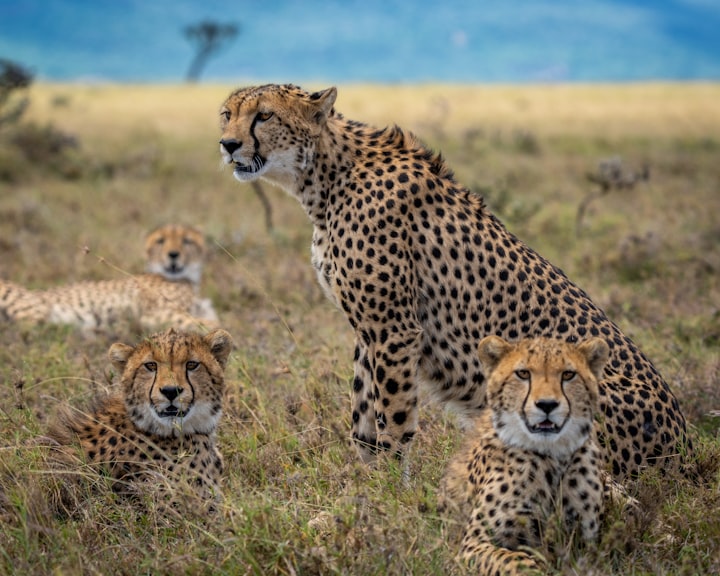
Cheetahs
Cheetahs are majestic creatures that are known for their speed, grace, and agility. They are the fastest land animal in the world and can reach speeds of up to 70 miles per hour. Cheetahs are native to Africa and are found in a variety of habitats, including grasslands, savannas, and desert regions.
Physical Characteristics
Cheetahs are medium-sized carnivorous mammals with a lean and muscular body designed for speed and agility. They have a distinctive spotted coat, which provides excellent camouflage in the grasslands and savannas where they live. The spots are solid black and are evenly spaced throughout their tan or golden-colored coat. Cheetahs have a small, rounded head with high-set eyes and a black stripe that runs from the corner of each eye to the mouth, which is thought to help deflect the sun's glare.
Cheetahs have long, thin legs that are designed for running at high speeds. Their back legs are longer than their front legs, which helps them to maintain balance and make sharp turns while chasing prey. Their paws have non-retractable claws, which provide traction and grip when running and hunting. Cheetahs also have a long, slender tail that helps them to balance and turn at high speeds.
Adult cheetahs can weigh between 70 and 140 pounds, and their height at the shoulder ranges from 28 to 35 inches. Males are slightly larger than females. Cheetahs have a distinctive black "tear mark" that runs from the corner of each eye to the mouth. This tear mark may help to reduce glare from the sun and improve their vision during hunts.
In summary, cheetahs are well-adapted to their environment with their lean and muscular body, distinctive spotted coat, long thin legs, non-retractable claws, and a long slender tail. These physical characteristics make cheetahs one of the most iconic and recognizable animals in the world.
Behavior and Diet
Cheetahs are primarily solitary animals, although they may form temporary groups for mating or raising young cubs. They are diurnal and are most active during the day. Cheetahs are known for their incredible speed, agility, and hunting skills. They can reach speeds of up to 70 miles per hour, making them the fastest land animal in the world.
Cheetahs are carnivores and mainly prey on small to medium-sized herbivores, such as gazelles, impalas, and springboks. They use their speed and agility to chase down their prey and have been known to catch animals that are much larger than themselves. Cheetahs use their keen eyesight to locate prey from a distance and will stalk and approach their prey as closely as possible before sprinting after them in a burst of speed.
After catching their prey, cheetahs will often suffocate it by biting its throat or mouth, which cuts off the oxygen supply to the brain. Cheetahs eat quickly to avoid having their prey stolen by other predators, such as lions or hyenas, and will often eat their prey while it is still alive.
Cheetahs have a unique hunting strategy compared to other large predators. They rely on speed and agility to catch their prey rather than strength and power. However, this hunting strategy is also risky because cheetahs tire quickly and are vulnerable to injury or attack if their prey fights back.
In addition to their hunting skills, cheetahs are also skilled climbers and are able to scale trees to avoid predators or to get a better view of their surroundings.
In summary, cheetahs are diurnal, solitary animals that are skilled hunters. They rely on speed and agility to catch their prey and have a unique hunting strategy compared to other large predators. Their diet mainly consists of small to medium-sized herbivores, and they have developed several adaptations to help them hunt and survive in their environment.
Conservation Status
Cheetahs are classified as a vulnerable species, with an estimated population of around 7,500 individuals in the wild. Their populations have been declining due to habitat loss, poaching, and human-wildlife conflict. Cheetahs are also susceptible to disease and genetic issues due to their limited genetic diversity. Conservation efforts are underway to help protect these animals, including habitat restoration, anti-poaching measures, and captive breeding programs.
Myths and Legends
Cheetahs have been a part of human culture for thousands of years and have been featured in many myths and legends. In ancient Egyptian culture, cheetahs were revered for their speed and grace, and were often associated with the goddess Mafdet. In some African cultures, cheetahs were believed to have supernatural powers and were considered to be messengers of the gods.
Conclusion
Cheetahs are an incredible species that have captured the imagination of people around the world. Their speed, grace, and agility make them a fascinating animal to observe and study. However, cheetah populations are declining, and it is important to take action to protect these animals and their habitats. Through conservation efforts and education, we can help ensure that cheetahs continue to thrive for generations to come.






Comments
There are no comments for this story
Be the first to respond and start the conversation.